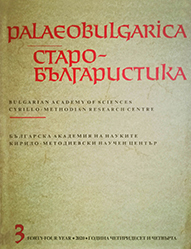Една непубликувана икона на светите Седмочисленици от фонда на Националната галерия в София – среща на културни влияния и модели
An Unpublished Icon of the Seven Slavic Saints (Heptarithmoi) from the Collection of the National Gallery in Sofia – A Meeting of Cultural Influences and Models
Author(s): Ralitsa RoussevaSubject(s): Language studies, Language and Literature Studies
Published by: Кирило-Методиевски научен център при Българска академия на науките
Keywords: Seven Slavic Saints (Heptarithmoi); icons; iconography; Bulgarian art; 19th century; lithography; Russian influences; Ohrid.
Summary/Abstract: The focus of the present study is an unpublished icon of the Seven Slavic Saints (Heptarithmoi) from the National Gallery in Sofia (№ NGFA, Ba-II-p-2; wood, tempera; 10 x 14 cm). It raises many questions beyond the specific artistic sphere, related to cultural influences from Mount Athos and Russia, changes in the veneration of Slavic Enlighteners, unknown primary literary sources, and others. The first thing that strikes the observer is the unusually small size of the icon, only 10 x 14 cm. It could have been intended for personal use or had the function of a kissing icon placed under a large icon of the Seven Slavic Saints. Seven full-length saints are depicted – five bishops and two monks. St Clement is depicted in the middle in full face, and the other figures are located symmetrically on both sides. A number is placed above the halo of each saint, and in the upper part of the icon the names of the saints are written corresponding to the respective number: 1. Св Кvріллъ Солун; 2. С. Методiй Солун; 3. С. Климен п. Охр.; 4. С. Наумъ Охридс; 5. С. Савва Охрид; 6. прпод. Гораздъ; 7. прпод. Ангеларій Германскій. Without connection to the historical evidence and the iconographic tradition St Naum is presented as a bishop, not as a monk, St Sava is also presented as a bishop, identified with the epithet Ohridski, and St Angelarius with the epithet Germanski. We find the same composition and non-traditional epithets of the saints in a color lithography with the images of the Seven Slavic Saints, printed in the printing house of A.V. Morozov in Moscow in 1869. According to Dimitar Usta-Genchov this lithography model was brought by Samokov to Moscow. The same composition and iconography, however, is found in three more icons: an icon from Varna, the work of Alexander Pop Georgiev from Yambol (1866, RHM–Varna), an icon from Tryavna (now unknown location, 1860s–1870s?), and an icon from Kalovo, Strandzha region (NCHAM, 1870s–1880s). This publication adds to a group of artworks on the small icon under consideration, each distinguished by an almost identical iconography and composition of their version of the Seven Slavic Saints. The small icon in question should be dated to the 1870s since the typological characteristics of the images, the vestments, even in detail, and the epithets of the saints are very similar to those of the lithography. Stylistically the icon demonstrates similarities with the works of the Tryavna workshop from this period. For the group of images the question of the historical and literary sources is important, in which St Naum is a bishop, St Sava is a bishop of Ohrid, and St Angelarius is marked as Germanski. This interpretation of the names of some of the Seven Slavic Saints, as well as of their iconography, which is not based on medieval historical sources, can be found in Paisii’s Slavo-Bulgarian History and editions similar to Hrystaki Pavlovich's Tsarstvenik, but also in the printed editions in Russia in the nineteenth century, especially after 1862. As a conclusion, we can say that in the 1860s a new model of the composition of the Seven Slavic Saints was established in Bulgarian art, which is not related to the previous iconographic tradition and the medieval historical sources.
Journal: PALAEOBULGARICA / СТАРОБЪЛГАРИСТИКА
- Issue Year: 2020
- Issue No: 3
- Page Range: 24-41
- Page Count: 18
- Language: Bulgarian
- Content File-PDF

